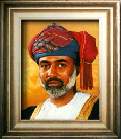|

| Country
Status |
| Independent
Sultanate. |
| Capital |
| Musqat |
| Population |
| 2,200,000 |
| Religion |
| Islam |
| Head
of State |
|

Sultan
Qaboos bin Said
|
| Languages |
| Arabic
(official), English. |
| Land
Surface |
| 212,000
km² |
| Currency |
1
Rial = 1000 Baiza.
1 Rial = US$2.56
US$1 = 0.390 Rial |
| Local
Time |
| 4
hours ahead of GMT. |
|
|
Sultanate
of Oman
is situated in the eastern corner of the Arabian peninsula. It
is divided into two parts — the main region with a coastline
along the Gulf of Oman and the Arabian Sea — and the enclave
of Ras Musandam, which is separated from main Oman by
territories of United Arab Emirates.
The climate of Oman is hot and arid. Daily average
temperatures vary between 21°C and 35°C, while annual
rainfall is only 100 mm.
The Gross Domestic Product (GDP) of Oman is 11.488 million
dollars. Until the discovery of oil, agriculture was the basis
of the Omani economy. It has been temporarily eclipsed by the
oil industry and the resultant construction boomed.
Agriculture still has considerable potential although the oil
industry is the main contributor to the national exchequer,
agriculture in Oman revolves around the growing of fruits,
vegetables, corn, and tobacco. Cattle rearing is also one of
the main occupations of the people in the mountains. Around
Salalah are coconut plantations, which are regarded as the
only area in the whole Arab world where coconut palm is grown.
GCC nationals are exempted from securing visas to enter the
country. All other nationalities need to possess a valid entry
visa. Health regulations for those entering the country have
to furnish certificates proving that they are free from
malaria, yellow fever, and AIDS.
Radio and television stations churn out a wide variety of programs
comparable to international standards. Oman has many Arabic
publications which are aimed at the native population. English
newspapers and magazines also exist but their circulation and
readership are limited. |